Chatbots powered by AI technology are often used in today’s world for personal assistance, business automation, and customer related services. What do they mean, and what is the function of chatbots? This article seeks to discuss the meaning of AI chatbots and their different types, along with describing how they work.
What is an AI Chatbot?
AI software is designed to conduct conversations with people via text and speech. This can now be done through an AI Chatbot, which is simply a virtual assistant. Unlike the other chatbots where all of the instructions must be included in a script, AI chatbots depend on Natural Language Processing (NLP) and Machine Learning (ML) for instruction follow and response generation.
The modern AI Chatbots is available on websites, various social media platforms, and messaging apps such as Facebook Messenger and WhatsApp.
What is the working procedure of an AI Chatbot?
An AI Chatbot works and relies on several technological different from each other but great in use together, they include:
1. NLP or Natural Language Processing
This technology serves as the heart of a Chatbot. They are able to converse with people because humans designed NLP. It takes information from the user and further breaks it down and filters into essential aspects of the data like context and intent.
2. ML or Machine Learning
With each conversation the AI Chatbot learns more information which enables it to enhance its ability to offer proficient solutions.
3. Dialog Management
This component ensures the conversation flows naturally. It helps the chatbot maintain context, remember previous interactions, and generate relevant follow-up questions.
4. Integration with APIs & Databases
Many AI chatbots connect with external systems (like CRM software or payment gateways) to fetch real-time data or perform actions (e.g., booking tickets, checking account balances).
5. Response Generation
Once the chatbot processes the input, it generates a response using either predefined templates (for rule-based answers) or dynamic AI-generated replies (for more complex queries).
Types of AI Chatbots
AI chatbots can be categorized based on their functionality and complexity:
1. Rule-Based Chatbots
- Follow a fixed set of rules.
- Work best for simple, predictable queries (e.g., FAQs).
- Cannot handle complex or unexpected questions.
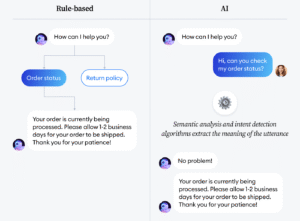
2. AI-Powered Chatbots
- Use NLP and ML for dynamic responses.
- Can understand slang, typos, and varied phrasing.
- Continuously improve through user interactions.
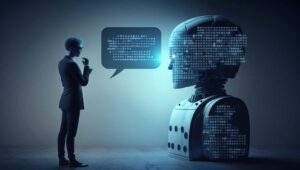
3. Hybrid Chatbots
- Combine rule-based and AI-driven approaches.
- Handle both structured and unstructured conversations efficiently.
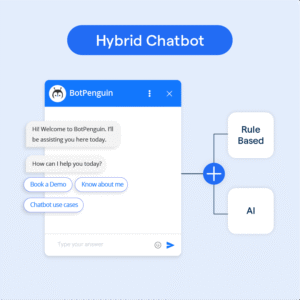
4. Voice-Activated Chatbots
- Operate via voice commands (e.g., Siri, Alexa).
- Use speech recognition technology to process requests.
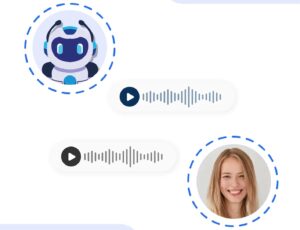
5. Transactional Chatbots
- Specialize in performing tasks (e.g., ordering food, booking flights).
- Often integrated with payment systems.
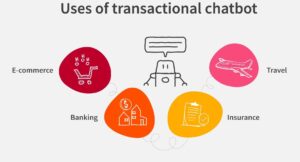
Benefits of AI Chatbots
- 24/7 Availability – Instant support anytime.
- Cost-Effective – Reduces human labor costs.
- Scalability – Handles thousands of queries simultaneously.
- Personalization – Tailors responses based on user history.
- Improved Customer Experience – Faster, more accurate responses.
Challenges of AI Chatbots
- Misinterpretation – May fail to understand complex queries.
- Lack of Emotional Intelligence – Struggles with empathy and nuanced conversations.
- Data Privacy Concerns – Requires secure handling of user information.
Conclusion
AI chatbots are changing the way people and businesses interact with technology. Due to the development of Natural Language Processing (NLP), machine learning, and sophisticated dialogue frameworks, these chatbots offer effective, intelligent, flexible, and automated means of communication. Despite challenges such as misunderstanding and privacy issues, ongoing improvements in AI technology make them smarter and more dependable. Try our free trial on our website.
Grasping the fundamentals of AI technology is beneficial for businesses seeking to enhance customer service and users who are interested in exploring AI, AI chatbots, and their associated capabilities.
Frequently Asked Questions (FAQs)
1. What is the primary objective of an AI chatbot?
An AI chatbot’s primary purpose is providing immediate feedback, automating conversations, and aiding in customer service, booking, and information retrieval.
2. Is it possible for AI chatbots to take over human agents’ jobs?
Certainly not; while AI does efficiently tackle repetitive functions, emotionally charged and complicated interactions can only be handled by a human.
3. In what ways do AI chatbots acquire new information?
AI chatbots utilize machine learning to improve responses over time by analyzing past interactions and recognizing patterns within the conversation.
4. Is the use of AI chatbots safe?
Yes, reputable chatbots apply encryption and obey data privacy laws, but users should refrain from offering sensitive information just to be safe.


